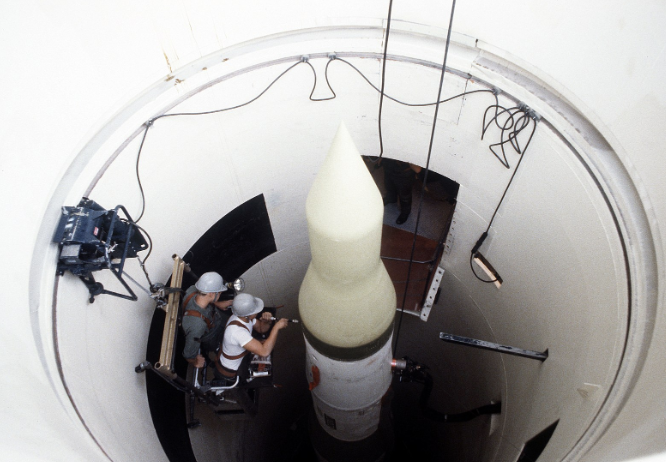The Ever-Present Nuclear Threat
“Minuteman II in silo 1980” by Bob Wickley from the public domain https://en.m.wikipedia.org/wiki/File:Minuteman_II_in_silo_1980.jpg
At any given point, the world could be 30 minutes from complete elimination. First developed by the United States during World War II, the atomic bomb eternally changed the way diplomacy works and wars are fought. Their advent has meant we exist in a world constantly capable of destroying itself. The Bulletin of Atomic Scientists, a global nonprofit focused on science and security, publishes the atomic clock, a measure of how close we are to destroying the planet. It’s currently set at just 90 seconds from midnight, just a few ticks from global catastrophe. The effects of the first atomic bombs, used in Hiroshima and Nagaski, demonstrated just how horrifying nuclear weaponry is. Since 1945, the bombs have only gotten bigger, more powerful, and more transportable. According to the Arms Control Association, nine countries are currently nuclear capable with a total of 12,512 warheads, totaling tens of thousands of megatons of TNT. No matter how one wants to spin it, the earth as a whole is at an extremely dangerous crossroads, with various conflicts making the threat of nuclear war a true possibility. So why don’t we think about this more often? And should we be more aware?
From 1949 to 1989, the threat of nuclear annihilation persisted as a result of the Cold War. Children practiced bomb drills for decades, families stocked jars of food in fallout shelters, and the entirety of Earth constantly lived on edge. However, for most, these fears have greatly regressed since the end of the Cold War despite large advancements in nuclear weapon lethality. Did the constant fear tire us out, leaving us vulnerable? Or did the 45+ years of the Cold War without nuclear armageddon lull us into a false sense of security?
I, for one, rarely think about the fact that at any given moment, I’m minutes from a dramatic nuclear demise. In asking friends and family members if this thought ever crosses their minds, I was met with a resounding no. Are we as a people blissfully unaware? Or are we just choosing not to acknowledge the fact that we’re teetering on the edge of disaster? In some ways, the advent of science fiction and the mainstream usage of nuclear weapons in the media has normalized nuclear weaponry and desensitized us to what could possibly come. Some people choose to think of the chance of nuclear war as so low that it’s no greater than an uncontrollable freak accident like an asteroid impact. Many people see it as a hypothetical situation, something that is likely impossible. And some are cognizant of the threat while also believing that there is quite literally nothing that we, as average citizens, can do about it. Why waste our time being anxious or worrying when we can’t change a thing? While this is a fair attitude to deal with the potential stress, we do need to remain apprised of where we’re at when it comes to the most dangerous weapon that the world faces. In 2022, Russia came extremely close to using a tactical or battlefield nuclear weapon against Ukraine. The United States carried out an “unprecedented level of contingency planning carried out as senior members of the Biden administration became increasingly alarmed by the situation.” Most people had no clue. It wasn’t until researching this piece that I realized just how close things got. As a whole, myself included, we must be aware of the dangers we face, some of them imminently threatening.
Ultimately, we need to be more aware of the threats we face everyday, not just when it comes to nuclear weapons. The planet is unstable. There has been the aforementioned turmoil between Russia and Ukraine for multiple years, originating during the Cold War when the nuclear threat first came to be. Decades of unrest in the Middle East, in addition to various conflicts elsewhere, also have the world living precariously on the edge. And to top it off, Iran, a nation on the verge of nuclear capabilities has entered the fray. At any given moment, a despotic leader could press a button, changing the globe forever.
Hopefully we never will find out what happens 30 minutes after launch. Maybe Oppenheimer will be right in saying that the advent of the bomb made sure that it was never used for true global war. But in the meantime, is there anything we can actually do to change the status quo and shift the atomic clock counterclockwise? California congressman Ted Lieu, who has worked to reduce nuclear risk, says that even just approaching your elected representatives about the issue helps. “Many members of Congress don’t run for Congress because of nuclear weapons,” Lieu said. “So it’s just an area where I think you can get members of Congress to engage and focus on and think about in a different way, because they may not have a very strongly held belief one way or the other.” The International Campaign to Abolish Nuclear Weapons (ICAN) says that educating ourselves and speaking out against nuclear weapons at all levels is critical to change. Although Oppenheimer’s words are technically correct until they’re not, all it will take is one weapon fired to completely shatter the world permanently.

